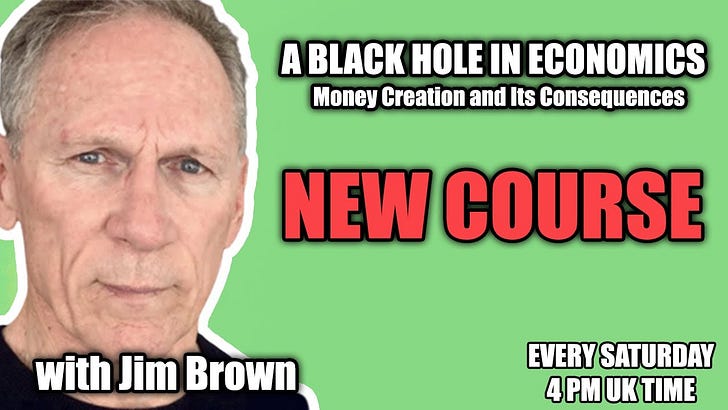A Black Hole In Economics: Money Creation And Its Consequences, Session One
Money Creation: Who Cares?
I’m happy to be back after a ten-week hiatus, during which I presented a nine-session course on money creation to the Ayn Rand Centre - UK YouTube network. The entire course is now available to everyone at no charge here on my Substack forum. I’ll send out one session at a time for the next nine weeks, skipping a week during the holidays.
I always look forward to comments, but for these sessions, I’ll love them even more. The reason is that I plan to turn the content of this course into a book during the coming year. Any feedback, pro or con, would be deeply appreciated and helpful to this first-time book writer!
I've attached a 70-minute video, Session One, introducing the course. Why is understanding money creation important, and why is this topic so poorly understood? In addition, I outline the course in detail so you know where we are going.
As usual, a manuscript of detailed notes is attached for those who would prefer to read the content or examine my sources and references, all of which are fully documented.
Most people can enjoy this lecture at 1.25x.
Please “like” it, forward it, and comment below!





Sorry to point out that there are some misunderstandings here. You say at (24:20):
"... and cash reserves move when deposits move from bank to bank..."
The point is that deposits essentially represent a relationship between the customer and the bank, whereby the deposits, which are a floating debt of the bank, have their counterpart in the claims of the customer - one does not exist without the other. This is an expression of the central principle of accounting, according to which there is no entry without an offsetting entry. This means that a deposit ALWAYS has a counterpart, regardless of which side you look at it from.
A deposit is therefore a debt relationship and debt relationships are defined between two precisely defined parties. Such a debt relationship between a buyer and his bank can be referred to as a DRb (= Debt Relation buyer). After a transfer to the seller, this debt relation DRb disappears (direct debit), while the seller and his bank establish a new debt relation DRs (credit note), which has NOTHING to do with the debt relation DRb. Even if both are for the same amount, they are not the same thing. DRb has ceased to exist, while DRs has been created NEW. You can say that one is conditioned by the other, but conditionality does not mean identity.
In short: deposits do not move! They are created and pass away - but they do not move.
In case you are interested in the processes that actually take place during a transfer:
https://reneemenendez.substack.com/p/who-is-transferring-money-when-a?utm_source=profile&utm_medium=reader2
Hi Jim, great introduction. I am really looking forward to this series.
As someone who thinks that money is precious metals and PM only, do you differentiate between fiduciary media and credit? And if so, how? And if "standard money" like cash and bank reserves are liabilities of the central bank, doesn't that make them credit?
Thanks.